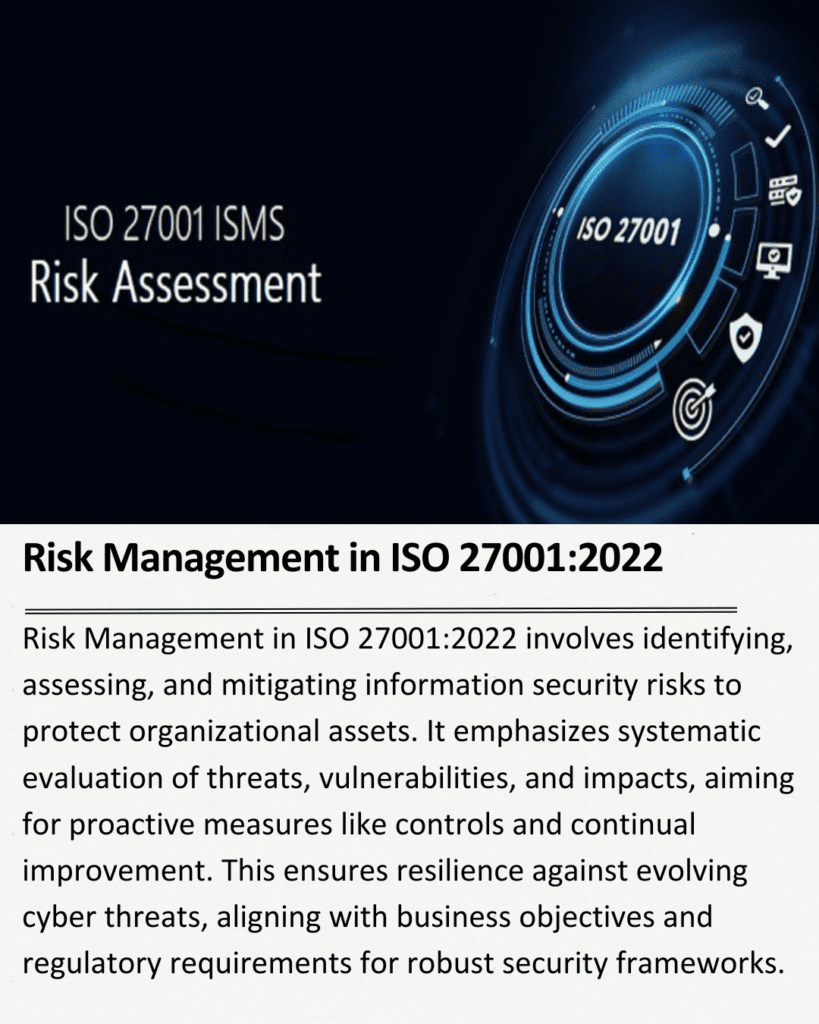Subtotal $0.00

Risk management in ISO 27001:2022 is crucial for safeguarding organizational assets and ensuring information security. This comprehensive guide explores the best practices and methodologies for effective risk management within the framework of ISO 27001:2022, emphasizing proactive strategies to mitigate threats and enhance cybersecurity posture.
Introduction to ISO 27001:2022
ISO 27001:2022 is the latest iteration of the international standard for Information Security Management Systems (ISMS). It provides a systematic approach to managing sensitive company information, ensuring its confidentiality, integrity, and availability. Central to ISO 27001 is the process of risk management, which helps organizations identify, assess, and treat information security risks.
Understanding Risk Management in ISO 27001:2022
1. Risk Assessment
The foundation of effective risk management in ISO 27001:2022 begins with a thorough risk assessment. This process involves identifying potential threats to information security, evaluating the likelihood of these threats occurring, and assessing their potential impact on the organization. Risk assessments should be conducted regularly and systematically, considering internal and external factors that could affect information security.
2. Risk Identification
Identifying risks involves recognizing vulnerabilities within the organization’s information systems, processes, and assets. This includes understanding potential threats such as cyberattacks, data breaches, system failures, and human errors. ISO 27001:2022 encourages a comprehensive approach to identify both existing and emerging risks, ensuring all aspects of the organization’s operations are considered.
3. Risk Analysis
Once risks are identified, they must be analyzed to determine their significance and prioritize them based on their potential impact and likelihood of occurrence. Risk analysis in ISO 27001:2022 involves quantifying risks where possible and qualitatively assessing those that are more difficult to measure. This step helps organizations allocate resources effectively to mitigate the most critical risks first.
4. Risk Treatment
After analyzing risks, organizations need to decide how to address them. Risk treatment options include risk avoidance, risk reduction, risk sharing, or risk acceptance. ISO 27001:2022 emphasizes selecting appropriate controls and safeguards to manage identified risks effectively. Organizations should implement controls that reduce risks to an acceptable level while considering cost-effectiveness and operational feasibility.
5. Risk Monitoring and Review
Risk management in ISO 27001:2022 is not a one-time process but requires continuous monitoring and review. Organizations must regularly assess the effectiveness of implemented controls, monitor changes in the risk landscape, and update their risk treatment plans as necessary. This iterative approach ensures that information security measures remain robust and responsive to evolving threats and business conditions.
Best Practices for Effective Risk Management
1. Top Management Commitment
Successful risk management begins with strong leadership and commitment from top management. Executives should demonstrate support for information security initiatives, allocate resources, and establish a culture of risk awareness throughout the organization.
2. Integrated Approach
Integrate risk management into the organization’s overall business processes and decision-making. Align information security objectives with business objectives to ensure that risk management activities support strategic goals and contribute to organizational success.
3. Risk Communication
Effective communication is essential for successful risk management. Ensure that stakeholders across the organization understand their roles and responsibilities in managing risks. Encourage open communication channels to report security incidents, vulnerabilities, and emerging threats promptly.
4. Training and Awareness
Invest in training programs to enhance employees’ understanding of information security risks and their role in mitigating them. Foster a culture of security awareness through regular training sessions, workshops, and communication campaigns.
5. Regular Audits and Assessments
Conduct regular audits and assessments to evaluate the effectiveness of implemented controls and identify areas for improvement. External audits may be necessary to validate compliance with ISO 27001:2022 requirements and provide assurance to stakeholders.
6. Continuous Improvement
Implement a process of continuous improvement to adapt to changing threats, technologies, and regulatory requirements. Regularly review and update risk assessments, treatment plans, and security controls to maintain resilience against emerging risks.
Methodologies for Effective Risk Management
1. ISO 27005 Framework
ISO 27005 provides a structured approach to risk management within the context of an ISMS. It outlines steps for risk assessment, risk treatment, and risk acceptance tailored to the organization’s specific needs and risk tolerance.
2. NIST Cybersecurity Framework
The National Institute of Standards and Technology (NIST) Cybersecurity Framework offers guidelines, standards, and best practices for managing cybersecurity risks. Organizations can integrate NIST’s risk management framework with ISO 27001:2022 to enhance their overall information security posture.
3. COBIT Framework
Control Objectives for Information and Related Technologies (COBIT) provides a governance and management framework for enterprise IT. It includes risk management processes that align with ISO 27001:2022 requirements, focusing on IT governance, control objectives, and risk assessment.
Conclusion
Effective risk management is fundamental to achieving and maintaining ISO 27001:2022 certification. By following best practices and methodologies outlined in this guide, organizations can strengthen their information security defenses, mitigate threats effectively, and demonstrate commitment to protecting sensitive information. Continuous improvement and proactive risk management are key to adapting to evolving cybersecurity threats and regulatory changes, ensuring long-term resilience and compliance with ISO 27001:2022 standards.